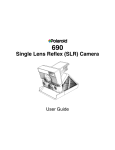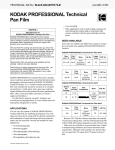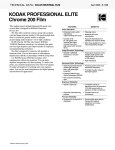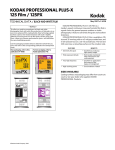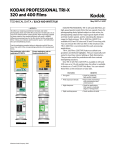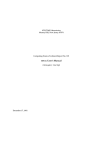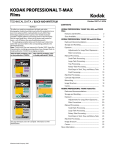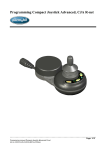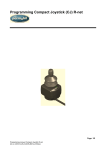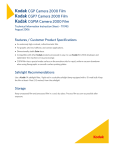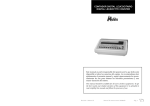Download 2nd Ave. KODAK F-12 Owner's Manual
Transcript
TECHNICAL DATA / BLACK-AND-WHITE FILM December 2002 • F-12 KODAK EKTAGRAPHIC HC Slide Film —NOTICE— EXPOSURE This film has been discontinued. KODAK EKTAGRAPHIC HC Slide Film is a negativeworking, orthochromatic film that is designed for making reverse-text black-and-white title slides (e.g., if your originals have black letters on a white background, they will reproduce as white letters on a black background). This film, features extremely high contrast, and wide exposure and development latitude—you get high contrast with opaque blacks and clear whites. FEATURES BENEFITS • Extremely high contrast • Opaque blacks and crisp whites for dramatic, legible titles • Same emulsion and base as KODAK PROFESSIONAL KODALITH Ortho Film 6556, Type 3 • Easy processing in KODAK PROFESSIONAL KODALITH Super RT Developer SIZES AVAILABLE Roll Base Letter Code CAT No. 135-36 5.3-mil acetate HCS 863 0133 STORAGE AND HANDLING Store unexposed film at 75°F (24°C) or lower in the original package. Always store film (exposed or unexposed) in a cool, dry place. For best results, process film as soon as possible after exposure. Protect processed film from strong light, and store it in a cool, dry place. For more information on storing negatives, see KODAK Publication No. E-30, Storage and Care of Photographic Materials—Before and After Processing. ©Eastman Kodak Company, 1998 To find the best exposure for your copying equipment when first using this film, make a trial exposure series. Adjust the camera f-stop in 1⁄3-stop increments for a total of 7 exposures (3 above and 3 below your starting point). To determine the starting-point exposure time and aperture setting for the series, measure the illumination on the original material. Take a direct reading with an incident-light meter, or read a gray card (18% reflectance side) on the copyboard with a reflected light meter. Set the exposure meter at Exposure Index (EI) 25 if the film will be developed in KODAK Developer D-11, or EI 8 if developed in KODAK PROFESSIONAL KODALITH Super RT Developer (see “Processing”). To determine your first set of trial exposures, set the shutter speed at 1 second and make an exposure at every f-stop on the lens. Record the f-stop of the best exposure and note the lens and lighting arrangement; use these data as a starting point with other originals. After this initial test, bracket two stops on each side of the best exposure using 1⁄ -stop increments; exposures will vary somewhat with the 3 width of the lines and the type size of the artwork. Example: With four 200-watt tungsten lamps, two on each side of the original, and the shutter speed set at 1 second, the best exposure should be between f/5.6 and f/11. If you use two 200-watt lamps, one on each side of the original, the best exposure should be between f/4 and f/8. Exposure and Development Adjustments for Long and Short Exposures At the exposure times in the table below, compensate for the reciprocity characteristics of this film by increasing exposure and adjusting the development as shown. If Indicated Exposure Time Is (Seconds) Use This LensOR Aperture Adjustment This Adjusted Exposure Time (Seconds) AND Use This Development Adjustment Use a safelight equipped with a KODAK 1A Safelight Filter (light red) with a 15-watt bulb. Keep the safelight at least 4 feet (1.2 metres) from the film. Run tests to determine that safelight use gives acceptable results for your application. For information on safelight testing, see KODAK Publication K-4, How Safe Is Your Safelight? PROCESSING 1/1,000 None None None Small-Tank Processing (8- or 16-ounce tank) 1/100 None None None 1/10 None None None 1 +1 stop 2 -10% Develop EKTAGRAPHIC HC Slide Film at 68°F (20°C) in a small tank. We recommend using KODAK Developer D-11 or KODAK PROFESSIONAL KODALITH Super RT Developer for processing this film. KODAK Developer D-11 provides slightly lower contrast, more exposure latitude, longer solution life, and high projection contrast. It also produces faster film speed or short camera exposures. Note: For even development of the entire roll, first fill the tank with developer. Then, using the above safelight handling instructions, drop the loaded film reel into the developer and attach the top to the tank. Firmly tap the tank on the top of the work surface to dislodge any air bubbles. Agitate for 5 seconds every 30 seconds throughout development. You can do the remaining operation in room light. 10 +2 stops 50 -20% 100 +3 stops 1,200 -30% (Minutes) Average Adjustment for Most KODAK Black-and-White Films (Seconds) It may be difficult to use the table to estimate the adjusted times for calculated exposure times between 1 and 100 seconds. The graphs below will help you find the adjusted times for calculated exposure times between those given in the table. Step/Solution 20 1,200 50 18 1,100 17 30 1,000 16 15 900 20 14 13 800 10 12 1 2 3 4 5 6 7 8 9 10 CALCULATED EXPOSURE TIME (Seconds) 700 11 10 600 9 8 7 500 400 6 5 4 3 2 1 10 20 30 40 50 60 70 80 90 CALCULATED EXPOSURE TIME (Seconds) 100 Time (min:sec) Develop at 68°F (20°C) 19 40 300 200 100 ADJUSTED EXPOSURE TIME ADJUSTED EXPOSURE TIME (Seconds) DARKROOM RECOMMENDATIONS KODAK Developer D-11 2:30 KODAK PROFESSIONAL KODALITH Super RT Developer 2:45 Rinse at 65 to 70°F (18 to 21°C)—with agitation: KODAK Indicator Stop Bath 0:10 Fix at 65 to 70°F (18 to 21°C)—with frequent agitation*: KODAK Fixer 2:00 to 4:00 KODAK Rapid Fixer 1:00 to 2:00 KODAFIX Solution 2:00 to 4:00 Wash at 65 to 70°F (18 to 21°C): Running water —OR— Rinse with water KODAK Hypo Clearing Agent Running water 10:00 0:30 1:00 to 2:00 5:00 Final rinse: KODAK PHOTO-FLO Solution 0:30 Dry—in a dust-free place * If you are going to hand-color this film, do not overfix or overharden it. 2 KODAK EKTAGRAPHIC HC Slide Film • F-12 ARTWORK Cleanliness and good contrast are important for best results. Use black ink, black crayon, black transfer letters on a white background, black letters obtained from a lettering machine, or type set by a local printer. Try to maintain an even density of black. Also make sure that the lettering or artwork meets minimum legibility requirements. such as KODAK Opaque Black, CAT 146 4312. Many of the black pens and pencils sold for marking overhead projector transparencies also work well in this application. IMAGE-STRUCTURE CHARACTERISTICS The data in this section is based on development at 68°F (20°C) in KODAK Developer D-11 for 2 minutes in a small tank. COPYING PROCEDURE COLORING THE SLIDES You can color the dry transparency by using a cotton swab to apply the dye or by dipping it in water-soluble dyes, such as KODAK Liquid Retouching Colors, CAT 190 1743, or ordinary food coloring. An alternative to using dyes is to mount a colored filter with the slide. Theatrical gelatin filters are available in sheets in a variety of colors and shades. Characteristic Curves 4.0 Process: Small Tank; KODALITH Super RT Developer 68°F (20°C) Tungsten: 10 seconds DENSITY 3.0 3 1/4 min 2.0 2 3/4 min 2 1/4 min 1.0 0.0 1.0 0.0 F009_0100AC 2.0 1.0 3.0 LOG EXPOSURE (lux-seconds) 4.0 Process: Small Tank; KODAK Developer D-11, 68°F (20°C) Tungsten: 10 seconds 3.0 3 min DENSITY When you are making slides of lettering or artwork, a singlelens-reflex camera offers a decided advantage because you can compose and focus the image in the camera viewfinder. You may need a supplementary close-up lens or macro lens, especially if the artwork contains fine detail. We recommend that you use a matched pair of 200 W tungsten lamps or two tungsten-halogen photolamps, in a fixed position, for illumination on the sides of the copy stand. Determine the best shutter speed and lens aperture combination for a given lighting setup and title by a trial exposure series, using the suggested exposure index (EI) as a starting point. Use EI 25 when processing in KODAK Developer D-11 and EI 8 when processing in KODAK PROFESSIONAL KODALITH Super RT Developer. One method to determine the initial exposure time and aperture setting (f/number) for the test series is to measure the illumination on the original material. Take a direct reading with an incident-light meter, or read a gray card with a reflected light meter. You’ll find that the built-in camera light meters tend to underexpose white copy material because they average the reflected light from a wide area of the scene. However, you can use them satisfactorily with a gray card. Another method for determining your first set of trial exposures is to set the shutter speed at 1 second and take a shot at every f-stop on the lens. Record the f-stop of the best exposure and note the lens and lighting arrangement so you can produce good results again in the future. 2 1/2 min 2.0 2 min 1.0 0.0 1.0 F009_0101AC 0.0 1.0 2.0 3.0 LOG EXPOSURE (lux-seconds) OPAQUEING THE SLIDES One of the advantages of reverse-text slides made from highcontrast black-and-white films is the high-density background, which can conveniently cover up imperfections in the background of the original artwork. If, however, any dirt, sketch lines, or other objectionable marks on the art are reproduced on the processed film, these white marks can be easily painted out with opaque, a light-blocking compound, KODAK EKTAGRAPHIC HC Slide Film • F-12 3 KODAK EKTAGRAPHIC HC Slide Film MORE INFORMATION Kodak has many publications to assist you with information on Kodak products, equipment, and materials. The following publications are available from Kodak Customer Service, from dealers who sell Kodak products, or you can contact Kodak in your country for more information. E-30 Storage and Care of KODAK Photographic Materials—Before and After Processing E103BF KODAK PROFESSIONAL Black-and-White Films Matrix F-2 Pathways to Black and White K-4 How Safe Is Your Safelight? For the latest version of technical support publications for KODAK PROFESSIONAL Products, visit Kodak on-line at: http://www.kodak.com/go/professional If you have questions about KODAK PROFESSIONAL Products, call Kodak. In the U.S.A.: 1-800-242-2424, Ext. 19, Monday–Friday 9 a.m.–7 p.m. (Eastern time) In Canada: 1-800-465-6325, Monday–Friday 8 a.m.–5 p.m. (Eastern time) Note: The Kodak materials described in this publication for use with KODAK EKTAGRAPHIC HC Slide Film are available from dealers who supply KODAK PROFESSIONAL Products. You can use other materials, but you may not obtain similar results. KODAK EKTAGRAPHIC HC Slide Film KODAK Publication No. F-12 CAT 192 7995 Kodak, Kodak Professional, Ektagraphic, Kodafix, Kodalith, D-11, and Photo-Flo are trademarks. Minor Revision 12-02 Printed in U.S.A.




